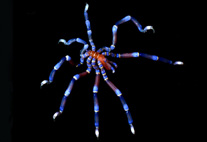Abstract
Skinks are usually grouped in a single family, Scincidae (1,579 species) representing one-quarter of all lizard species. Other large lizard families, such as Gekkonidae (s.l.) and Iguanidae (s.l.), have been partitioned into multiple families in recent years, based mainly on evidence from molecular phylogenies. Subfamilies and informal suprageneric groups have been used for skinks, defined by morphological traits and supported increasingly by molecular phylogenies. Recently, a seven-family classification for skinks was proposed to replace that largely informal classification, create more manageable taxa, and faciliate systematic research on skinks. Those families are Acontidae (26 sp.), Egerniidae (58 sp.), Eugongylidae (418 sp.), Lygosomidae (52 sp.), Mabuyidae (190 sp.), Sphenomorphidae (546 sp.), and Scincidae (273 sp.). Representatives of 125 (84%) of the 154 genera of skinks are available in the public sequence databases and have been placed in molecular phylogenies that support the recognition of these families. However, two other molecular clades with species that have long been considered distinctive morphologically belong to two new families described here, Ristellidae fam. nov. (14 sp.) and Ateuchosauridae fam. nov. (2 sp.). Morphological diagnoses and species content for all nine families of skinks (Scincomorpha) are presented.

